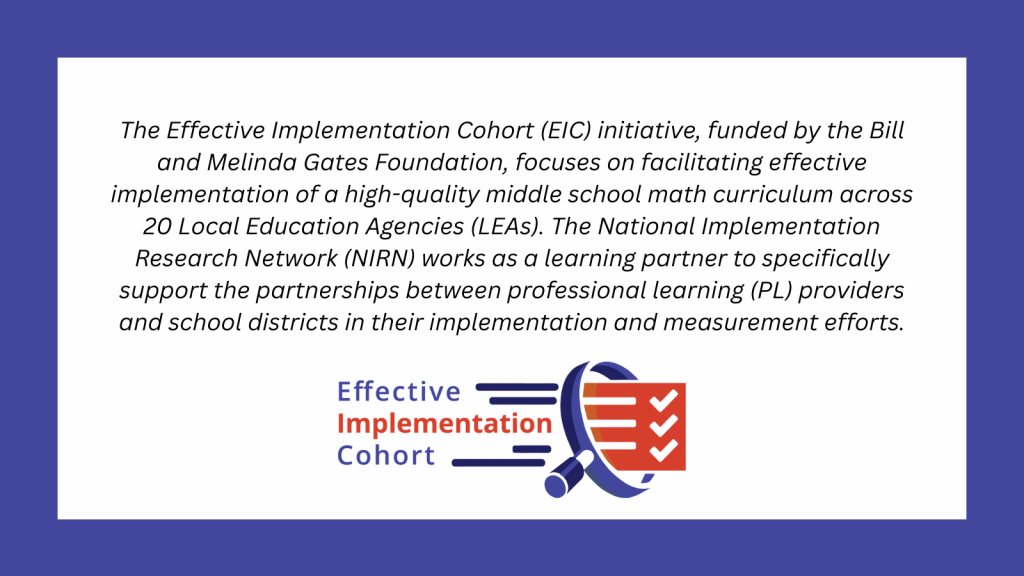Powerful Partners: Centering Student Voice in Implementation

Incorporating the perspectives, insights, and active participation of students when implementing evidence-based practices and programs (EBPs) is not just beneficial – it is essential. Beyond listening to students, including student voice involves empowering them as meaningful participants and decision-makers in shaping their own educational experiences.
Including critical perspectives such as students in work that affects them positively, impacts individual levels of self-efficacy, sense of connection, and empowerment (Kahne et al., 2022). Doing so also strengthens the implementation of EBPs by clarifying desired outcomes, facilitating collaborative problem-solving, and improving the overall fit of initiatives, thereby increasing chances of sustainment over time (Farmer & Perkins, 2023).
Despite the importance and benefit of doing so, including student voice in implementation efforts doesn’t always happen due to resource constraints, logistical issues, or lack of know-how. As a result, initiatives can experience low engagement, resistance to change, and outcomes that don’t reflect the real needs or experiences of the very students they aim to serve (Farmer & Perkins, 2023). School districts, funders, and professional learning providers may recognize the benefits of including student voice but struggle to integrate it consistently throughout their implementation journey.
In implementation science, a common motto is: “Get Started, Get Better”. It’s never too late to begin incorporating student voice into implementation efforts. Starting small with just one or two opportunities can build momentum, strengthen practice over time, and lead to deeper, more meaningful student engagement. Below are three practical strategies for doing so, with illustrative examples from NIRN’s Effective Implementation Cohort (EIC).
#1: Designing Data Collection Methods with Student Voice in Mind
Thoughtful planning should include student participation in shaping how data will be gathered. For example, teams can co-create survey questions with students to ensure the questions reflect their experiences and values related to the evidence-based practice (EBP). Students can also help identify which methods – for example, focus groups, journaling, or digital storytelling – feel most accessible and authentic to them, ensuring that teams consider the diverse needs and preferences of all learners in the building. While surveys are a valuable starting point for elevating student voice, they often surface deeper issues that require more interactive and nuanced platforms for expression. Creating space for follow-up through listening sessions, interviews, or other formats helps ensure students can expand on their experiences and insights. Involving students in these early decisions not only builds trust but ensures the data collected is more relevant and reflective of their lived realities.
The EIC project incorporated student surveys into its measurement plan during the initial design and planning period to ensure their experiences and feedback were continuously accounted for throughout implementation. The intent was to use the results to identify specific implementation barriers around topics of engagement and relevance. The purpose of the student survey was to help understand how and to what extent implementation affects students’ self-efficacy, value of math, enjoyment of math, and engagement with math. Although students were not direct co-creators in designing these surveys, the addition of student surveys to the EIC project intentionally created space for student experiences to be captured and used to inform/improve the districts’ math curricula implementation.
#2: Eliciting Ongoing Student Feedback to Improve in Real Time
By analyzing student feedback such as focus groups and surveys within data cycles, educators can make informed decisions that enhance implementation and responsiveness to student needs. This might involve adapting instructional strategies, adjusting school climate efforts, or rethinking support structures based on what students are saying. When students see their feedback result in real-time changes, it reinforces their role as valued partners in shaping their learning environments.
For example, at one middle school, students didn’t just voice concerns – they helped lead meaningful change. Students at the school felt overwhelmed by the pressure of standardized tests, believing that classes had shifted toward memorization rather than true learning. In response, a group formed a Student Advisory Workgroup to gather peer perspectives on how test prep affected mental health and engagement, especially in math. They compiled these insights and shared them with school leaders, but they didn’t stop there. The workgroup also proposed solutions: more project-based learning, alternative assessments, and “stress-buster” workshops before major exams. The administration piloted several of these suggestions, and the results were powerful—students felt more heard, supported, and engaged. The success of the pilot led to broader school-wide changes that created a more balanced learning environment.
This example illustrates how structured student feedback, when paired with a clear process for listening, reflecting, and acting, can improve both the experience and outcomes of education. When feedback isn’t just collected but used, students become true partners in shaping their learning environment.
To ensure inclusivity, it’s essential to offer multiple options for students to share their thoughts, recognizing not only that comfort levels vary but also that accessible, intentionally designed opportunities are needed to meet the diverse ways students learn and engage. Student input should be collected through various means, including surveys, interviews, and informal check-ins. Regular opportunities for feedback, both structured and spontaneous, can help educators identify trends and surface issues that might otherwise go unnoticed. Additionally, these options for student input should include opportunities for students from diverse language backgrounds to share their perspectives and feedback.
Some districts and providers in the EIC project incorporated student voice by administering focus groups, which provided real-time insights into student experiences. These focus groups captured student and caregiver voices and allowed for a clearer understanding of needs, exploration of new ideas, and the creation of intentional decision-making.
#3: Engaging Students as Partners in Dissemination
Encouraging students to participate in opportunities to share their experiences from using the EBP, such as conference/convening panels, providing quotes to a publication, or sharing their stories via video and other media, can amplify their voice, even when they cannot be physically present. Creating structured opportunities for students to express their experiences helps build momentum and sustainability for future innovations. This might include publishing student reflections, hosting exhibitions or showcases, or integrating student feedback into end-of-year reports. When student insights are treated as key outcomes of the innovation, it reinforces the value of their voice and models a culture of shared ownership and learning.
During the EIC project, two in-person convenings were held in representative cities and districts from the cohort (San Diego, CA, and Austin, TX). For both events, thoughtful planning for student inclusion was incorporated into the design of the convenings. One truly unique and memorable aspect was the rich interaction where students discussed their opinions, thoughts, and ideas with adults who were involved and informed at every level of the project. The students’ insights sparked genuine interest and thoughtful follow-up from these adults, creating a powerful sense of two-way communication.
Additional Considerations for Effective Student Voice Integration
- Tailoring Engagement Methods to Student Populations: When focusing on specific student groups, engagement methods should be age-appropriate and culturally and linguistically relevant. This ensures students can meaningfully participate in ways that resonate with their developmental stage, lived experiences, and cultural context, making their input more authentic and actionable.
- Involving Caregivers: Parents and caregivers play a vital role in supporting and reinforcing student learning. Finding ways to include the caregiver’s voice along with students’ helps create a better understanding of student needs. It strengthens the bridge between home and school, increasing the likelihood of sustained engagement and success.
- Leveraging Teacher-Student Proximity: Teachers have direct insight into student needs and should be actively involved in eliciting student feedback. Because of their daily interactions with students, teachers are well-positioned to facilitate meaningful conversations, interpret student perspectives, and advocate for their inclusion in decision-making processes.
- Utilizing Existing Student Groups: Tapping into pre-established student organizations makes gathering input more efficient and effective. Such groups serve as a natural entry point for gathering student voices, given the established relationship and trust already built with those in them.
Conclusion
Centering student voice throughout the implementation process leads to more meaningful, effective, and sustainable change. By embedding student perspectives in planning, implementation, and reflection, we ensure that EBPs truly serve the students they are designed to benefit. When students are treated as co-creators rather than passive recipients, they become more engaged, invested, and empowered. Cultivating these authentic partnerships not only strengthens implementation efforts but also fosters a sense of belonging and agency that extends beyond the classroom.

References
Farmer, S., & Perkins, Y. (2023). Engaging critical perspectives. The University of North Carolina at Chapel Hill, Frank Porter Graham Child Development Institute, National Implementation Research Network. https://implementation.fpg.unc.edu/wp-content/uploads/Engaging-Critical-Perspectives-SISEP-Brief-1.1.pdf
Kahne, J., Bowyer, B., Marshall, J., & Hodgin, E. (2022). Is responsiveness to student voice related to academic outcomes? Strengthening the rationale for student voice in school reform. American Journal of Education, 128(3), 389–415. https://doi.org/10.1086/719121
Lac, V. T., & Cumings Mansfield, K. (2017). What Do Students Have to Do With Educational Leadership? Making a Case for Centering Student Voice. Journal of Research on Leadership Education, 13(1), 38-58. https://doi.org/10.1177/1942775117743748
